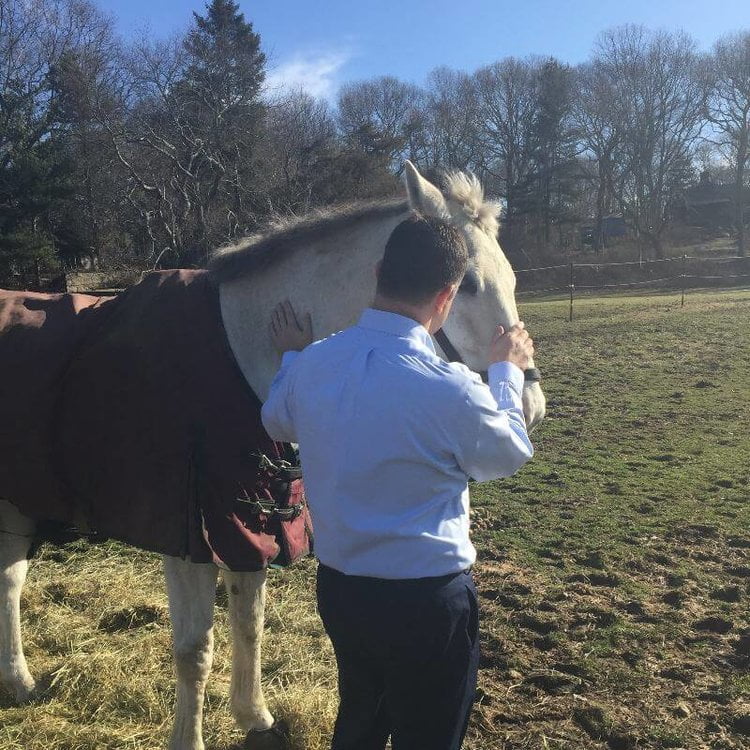I’d like to tell you a story. It’s a story about one of my clients who developed his own explanation of why intensive equine therapy (IET) works, or, I should say, can work.

But first, let me give some background. Everyone who uses horses to help others, calls their approach therapy. Most often we associate it with centers that help children with disabilities. Usually this is primarily concerned with caring for and riding horses – and there is no question that these activities offer physical and emotional benefits.
Our program is what we call intensive equine therapy (IET), trained psychologists and counselors combined with specially chosen horses for a defined range of emotional issues. There is no riding and horse care is incidental to the process. The client learns to communicate with the horse – talk to the horse if you will – and read the horse. It can be fun, it certainly is interesting, and it is work, takes focus and requires a horse with the ability to hold a connection. The client also interacts with the therapist – we call them trainers – in some ways similar to what you would find in an office setting, but highly skilled at reading and understanding horses and their behavior. We think our protocol is unique and quite often yields significant advantages and rewards.
Not that long ago I had a client, I’ll call him Jack, ex-military, with a wide range of PTSD symptoms along with other issues stemming back to childhood. Luckily he did not have the physical trauma from a concussion as so many veterans returning from the Mid-East exhibit. Despite being a successful computer executive, his problems grew worse, not better over time.

Jack chose to work with Rajah. After several three-hour and then a couple of one and a half-hour sessions, Jack reported significant relief, and in one instance essentially eliminated the emotional and behavioral issue that dominated his personal and professional life. Jack had a wider range of symptoms than almost anyone else I have seen. As he said one afternoon, “I have a stable of traumas, not very well held in by gates and fences.”
Now different people respond differently and each person has an individual view of his experience. If you ask each one why they think IET worked for them – most having come to us from a variety of other therapies – you will get back very personalized responses. I chose Jack’s analysis because it was well put together and fairly close to my own theory. He also didn’t mind me using his story. Here is Jack’s explanation; I’ll tell it as if I was he.
“Even in early childhood most of us develop emotional scars, for me it was Third Grade. Depending on our parents, environment, our genes and our peers we sit somewhere on a bell curve of emotional trauma. Things are fairly good or very bad at either end of this curve. By the time you reach high school, anywhere on that curve is painful and distressing. Most of that trauma is later forgotten through the process of becoming adults unless you are in the lower part of the curve, where painfully, the damage is still there. In any case the scars for all of us remain.
“Now let’s say at sometime later in life we have a crisis, either from a singular event or the buildup of a variety of stresses over time. Hopefully family, friends and time assist in our recovery but often that is not enough. To continue on the same path is to potentially risk career, marriage and health; for me marriage went first.
“What are our alternatives? Let me walk you through my thoughts and some of the things I tried before coming to horses. We can change our lifestyle, but that is not often a realistic or positive option. We can try meditation and mindfulness; no question these can work but they may not be strong enough or fast enough and by this time I was not together enough for successful meditation. In any case, it required more time than I had. However, in the longer term this is something I am attracted to and I am trying to adopt the practices followed by Emerson and Thoreau.
“I attempted conventional therapy, with two different people. All I can say is that it didn’t work for me. They didn’t point out anything I didn’t know already; more importantly, they didn’t offer any techniques to realign my emotional response to match my mental perception. My mind was well aware I shouldn’t feel threatened by something, but tell that to the rest of me.
“I heard about Beachwood from my minister. It sounded interesting enough to try. I went over and left a note.
“It took me about a half hour to get into my first session, then it gets to be you and the horse. That is probably why intensive sessions are three-hours long, much different than fifty minutes in an office. Many of my human attributes receded as I tried to communicate with the horse. I can see why they don’t have you ride. Riding, you still are a person attempting to take charge, learning a skill, just like at work.
“Here it becomes an existential situation. The horse doesn’t care about my color, sex, social status or if I have any money, it’s only concerned with whether I am a friend or foe; convincing him of the former is more difficult and takes more time than you think.
“Once you get into it seemed similar to mindfulness, I could lose myself and focus; the difference was that I got there much faster and I think I was much deeper into it than when I was taking meditation classes.
“Something rather strange occurred as well; I began to feel confident, making my issues smaller and less threatening. It affected my whole outlook and how I related to other people. This was no small achievement.
“Later in the session my trainer guided me to an understanding, not much different than what the two therapists suggested, but here I was in a state my emotional system could accept. As I moved through future sessions, this ability to align my emotional and rational realities instead of reacting with a conditioned response became my norm.
“There was one instance that was rather striking. A situational anxiety that was originally severe disappeared. After that happened I couldn’t understand why, I had ever had this fear to begin with. It’s like having a fear of flying and then later when you have overcome it you can’t imagine why it ever was.
“Your trainer becomes key in all this. The horse helps you get into a relaxed non-defensive state; the trainer guides you to establish a new emotional response to overlay the old one. Since I am a computer software guy I would say you are stripping out old code and rewriting new; you are undergoing a debugging procedure to come up with streamlined efficient code. In people, of course, it’s not that simple but that is how I like to think of it.”
Jack’s story of healing with horses is not uncommon. Thank you Jack, for your willingness to share your story.
